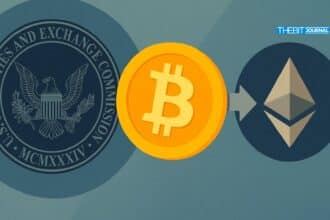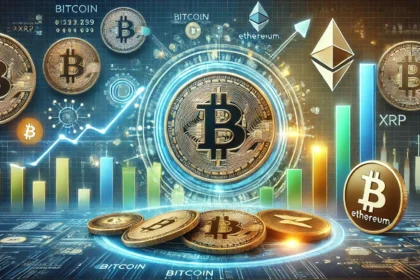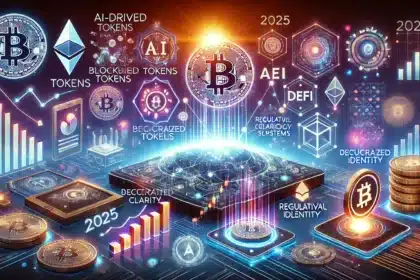A mysterious individual using the pseudonym Satoshi Nakamoto published the whitepaper “Bitcoin: A Peer-to-Peer Electronic Cash System” in 2008 and kickstarted the blockchain history. The mission was simple: to develop a decentralized network capable of transferring digital value without banks. The most critical element of the system was the blockchain. It was an immutable, decentralized record book that allowed humans to agree on things without necessarily trusting a central body.
A blockchain stores transactions in blocks connected with cryptographic hash. As everyone on the network has a copy of the ledger, modifying or tampering with records from the past is next to impossible. That was why folks thought this new idea was the linear solution to the 2008 global financial crisis, in which folks lost faith in the traditional banking system.
According to Blockchain and Data Integrity in Financial Reporting (May 2025), the decentralized design and cryptographic ledger structure of blockchain offer a credible solution for the consistency, accuracy, and transparence of financial records and data tampering and reporting mismatches.
Also, Scientific Reports (Feb 2025) published a paper on a decentralized trust model for smart cities and demonstrated that blockchain offers tamper-proof record‐keeping that supports governance transparency and trust in urban infrastructure
Breakthroughs Across Frontiers: Bitcoin to the Physical World
Bitcoin demonstrated the possibility of blockchain, yet Ethereum, introduced in 2015, transformed its mission. Ethereum-enabled smart contracts, automatic pieces of computer code that invoke action on the condition that specified circumstances exist. This enabled developers to construct decentralized applications (dApps), spawning the DeFi and NFT revolutions.
To Q2 2025, Ethereum remains the most adopted smart contracts platform. According to Etherscan, the Ethereum network transacts more than 1.1 million transactions on a daily basis. The ecosystem hosts thousands of protocols like Uniswap, Aave, and MakerDAO all running delegated fairly on autopilot in code.
Blockchain value has also been evident in the logistics, health, and governmental arenas. For instance, Walmart and BCG applied blockchain to trace the origin of food and reduced traceability from 7 days to 2.2 seconds, according to the IBM Blockchain Pulse.
Economic and Technological Advantages
Blockchain’s economic value lies in its three main properties: automation, decentralization, and transparency. It decreases the involvement of intermediaries and therefore reduces the cost of operations drastically and increases the velocity of transactions.
A PwC report calculated in 2020 that blockchain would add up to a value of $1.76 trillion to world GDP in 2030 from its use in provenance, payment, identity, contracts, and customer engagement.
Smart contracts allow businesses to transact processes with minimal or zero intermediaries. In finance, this has enabled decentralized lending, insurance, and the production of synthetic assets. In identity systems, governments such as Estonia have applied blockchain in offering e-residency and digital ID.
The Rise of Crypto Assets and Tokenization
Today’s blockchain ecosystem runs far beyond the realm of cryptocurrencies. The tokenization process of transforming physical or conventional financial assets into virtual tokens is gaining momentum on a global scale.
As per a BCG report from 2023, as much as $16 trillion in tokenized assets will be in the market by the year 2030. This encompasses even real estate and commodities. Blockchain provides these assets with the ability to be divided and traded 24/7.
Stablecoins like USDT and USDC pegged against fiat currencies now account for over $140 billion of circulating supply testified by CoinMarketCap.. Low-volume substitutes they pose have assumed a core position in on-chain transactions and cross-border remittances.

Identifying Key Indicators That Matter in Crypto Analysis
Blockchain networks and cryptographic currencies are monitored using specific indicators reflecting user activity and network health.
- Market Capitalization is the most used parameter. It’s calculated as the product of circulating supply and the value of the asset. Bitcoin’s market cap in July 2025 is higher than $1.3 trillion, and Ethereum’s market cap ranks second with $500 billion as per CoinGecko.
- Daily Active Users and Transactions show activity. Ethereum currently supports 1.1 to 1.5 million transactions per day, and Solana conducts over 60 million transactions per day as per Solana Explorer.
- Hash Rate also serves as the most crucial security of proof-of-work chains. Bitcoin hash rate exceeded over 600 exahashes per second (EH/s) in 2025, denoting healthy network vigor and vigorous miners’ participation as indicated by Blockchain.com.
- Total Value Locked (TVL) in DeFi is the level of the user’s trust in decentralized protocols. Here, the leader is Ethereum with over $50 billion TVL, followed by Tron and Arbitrum, DefiLlama statistics show.
Regulation: The Double Edge
As use increases, governments want to control blockchain technology. In the United States, the SEC has prosecuted projects that the SEC considers unregistered securities, such as XRP. Europe’s Markets in Crypto-Assets Regulation of MiCA from 2023 provides comprehensive regulations on the usage of the use of stablecoins, issuances of assets, and the protection of the consumer.
Financial Action Task Force (FATF) recommends that countries should subject the operators of crypto services to KYC/AML. It is a challenging issue to enforce the standards on the decentralized protocols.
Despite regulatory ambiguity, the adoption continues. Crypto adoption worldwide still is the greatest in Southeast Asia and Latin America and some parts of Africa in the underserved communities according to Chainalysis Global Crypto Adoption Index 2024.
What the Future Holds: Blockchain Beyond 2025
Blockchain is fast turning into mainstream digital infrastructure. Over 130 central banks from the United States and China to India and Uruguay and Zambia experiment or consider Central Bank Digital Currencies (CBDCs), says the Atlantic Council CBDC Tracker.
Layer-2 technologies like Arbitrum and Optimism are scaling Ethereum. The technologies transact off-chain and settle on-chain and reduce congestion and gas fees. Arbitrum alone has over $10 billion in TVL in mid-2025 per DefiLlama.
Even privacy technologies are being created. Zero-knowledge proofs (ZKPs) now enable secretive transactions with non-revelation of identities—shedding new light on enterprise and individual user potential.
Analysts look forward to the blockchain helping out mainline services from supply chains to voting systems in the year 2030. Although issues abound today, such as regulation, scaling, and user training, the long-term future is promising given the increase in ecosystem interoperability.
Conclusion:
Blockchain is something more than just a theory or a craze nowadays. It’s a more and more concrete reality of the world’s future. From virtual currencies to smart contracts, it’s allowing people and businesses to exchange value, create trust, and store information in safer and more transparent ways.
Millions of transactions take place on a daily basis on the Bitcoin, Ethereum, and Solana networks. Far from just being numbers, they show that blockchain increasingly is being applied in everyday life.
There are still issues to be addressed, like making the technology user-friendly and abiding by rules from governments. But this much is clear: blockchain is not disappearing. It is creating a world in which systems are more balanced, data is more secure, and people own more of the money and digital world.
Glossary of Terms
- Blockchain: An online book on which transactions are inscribed securely on a network.
- Smart Contract: A self-running program once the given conditions are met.
- DeFi (Decentralized Finance): Financial applications on the blockchain with zero intermediation.
- TVL (Total Value Locked): The total value locked in the DeFi protocols.
- Market Capitalization: The market value of all coins currently in circulation.
- Hash Rate: Computing power securing a proof-of-work chain.
- Stablecoin: A digital currency stabilized with a stable asset like USD.
- Proof-of-Stake: A consensus algorithm the validators being randomly chosen based on token holding.
- Layer-2 Solution: A top-layer on a blockchain to facilitate faster and less expensive transactions.
- Tokenization: Converting tangible world assets into cryptographic tokens.
Frequently Asked Questions
1. Is blockchain the same as cryptocurrency?
No. Blockchain is the technology behind cryptocurrencies. It’s used for many other applications too.
2. Is blockchain secure?
Yes, due to decentralization and encryption. However, poor smart contract design can still pose risks.
3. Can blockchain scale for global use?
Newer blockchains and Layer-2 solutions are making blockchain scalable enough for mainstream use.
4. Are all crypto assets legal?
Not all. Their legality depends on how regulators classify them in each country.
5. What is Solana used for?
Solana powers decentralized apps, NFTs, and DeFi tools, valued for its speed and low fees.
6. How much energy does blockchain consume?
Ethereum now uses over 99.9% less energy after its 2022 switch to proof-of-stake.
7. What is the future of blockchain?
It’s expected to underpin digital identity, finance, supply chains, and more by 2030.
Summary
This blog follows the history of blockchain from its Bitcoin origin to its status as the underlying infrastructure of decentralized finance, asset tokenization, and digital infrastructure. It includes authenticated data points such as Ethereum’s transaction volume, Solana’s throughput, and Bitcoin’s hash rate from blockchain explorers and giant analytics firms. It elucidates crucial indicators such as TVL, market cap, and hash rate, and examines global regulatory dynamics and global trends. The article combines technical specificity and readable writing and aims to enlighten crypto enthusiasts, students, and analysts. With estimates plotting out $16 trillion in tokenized assets in 2030 and over 130 countries exploring CBDCs, the prospect of blockchain relies on hard, data-floor movement.





























